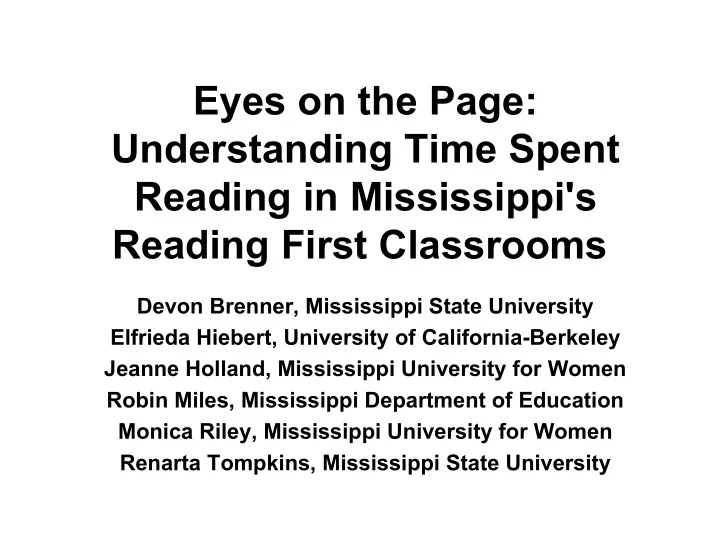

Eyes on the Page: Understanding Time Spent Reading in Mississippi's Reading First Classrooms Devon Brenner, Mississippi State University Elfrieda Hiebert, University of California-Berkeley Jeanne Holland, Mississippi University for Women Robin Miles, Mississippi Department of Education Monica Riley, Mississippi University for Women Renarta Tompkins, Mississippi State University
Examining Opportunity to Read • Time spent reading is related to fluency, vocabulary and comprehension achievement (Guthrie, Schaer, & Huang, 2001; Pinnell et. al., 1995) • Fluency—reading with appropriate rate and expression—is related to comprehension and overall reading achievement (Buck & Torgeson, 2003)
Opportunity to Read • Time spent reading builds fluency, it helps students become more automatic readers (Buck & Torgeson, 2003) • Children who read more learn more vocabulary (Critchley, 2006) • Matthew Effect (Cunningham & Stanovich, 1998)
Time Spent Reading • Provides one way of looking at the curriculum • Allows us to analyze one aspect of the impact of Reading First
How Much Reading? • Allington (2001) recommends 90 minutes during the school day • Fisher & Ivey (2006) suggest that for struggling readers time spent actively engaged in reading (and writing) “ought to substantially outweigh the amount of time students spend considering skills and strategies . . .” (p. 184) • More than half?
Reading First • Largest, most ambitious initiative for improving K-3 reading achievement • Low achieving, high poverty schools • Scientifically based reading research • Curriculum (SBRR core program) • Assessment • Professional development • Accountability
Reading First In Mississippi • 65 schools in 32 districts, 33 schools in year 4, 32 schools in year 2 of implementation • Literacy coaches and regional coordinators • Weekly Peer Coaching Study Teams • Core programs • Systematic assessment process • Professional development
Mississippi Reading First Demographic Characteristics Range Average Total Number N=18,895 286 of Students Percent Male 43%-59% 52% Students Percent Female 41%-57% 48% Students Percent 0%-1% 9% American Indian Percent Asian 0%-2% 0% Percent Black 12%-100% 83% Percent 0%-15% 1% Hispanic Percent White 0%-88% 15%
Mississippi Reading First Demographic Characteristics Percentages of Disadvantaged Students Lowest District Percentage of Students 56.4% Receiving Free/Reduced Lunch Highest District Percentage of Students 93.9% Receiving Free/Reduced Lunch Average District Percentage of Students 80.3% Receiving Free/Reduced Lunch
5 Research Questions • Time spent reading • Assisted vs. unassisted reading • Sources and genres of texts read • Differences in time reading by achievement (DIBELS) • Differences in opportunity read by length of implementation
Method • Observed in 2 classrooms in randomly selected school from each of 32 districts • Documented students’ reading behavior with an observational instrument • 6 students, girl and boy at 3 achievement levels • Observed for 30 seconds every 3 minutes • Coded reading behavior and text being read • Field notes
How many minutes of classroom reading instruction? 60 54 50 40 30 20 10 4 4 3 0 90 minutes 100 minutes 105 minutes 120 minutes
How many minutes with eyes on text in the RF classroom? • On average – 9.2 minutes during observation – 18.4 minutes during the entire instructional block
Minutes of Reading • Often not sustained • 18.4 greater than the national average of 8-12 (Donahue et. al., 2001) • 20% of instructional time • Less than the 2/3 of instruction suggested by Fisher and Ivey • Unlikely to lead to 90 minutes/day
How many minutes of assisted and unassisted reading? • Assisted reading—eyes on text while someone else reads aloud, choral, repeated, etc. • 4.8 minutes per observation • 9.6 minutes during instructional period • Just over half of time spent with eyes on text
How many minutes of assisted and unassisted reading? • Unassisted—independent reading (aloud or silent) • 4.4 minutes during observations • 8.8 minutes during instructional period • Less than half of time spent with yes on text
How many minutes of assisted and unassisted reading? • Assisted reading often encouraged by the basal program • Assisted reading may provide access to more challenging text (and often times basal passages are challenging for some students) (Stahl & Kuhn 2004) • However, limited time unassisted • Basal texts may contain high percentages of rare words, practicing those may not lead as directly to fluency with future passages as we would like
What types of texts are students reading? (Sources) Other 9% Leveled 22% Basal 53% Computer 3% Trade Book 10% Content Text 3%
What types of texts are students reading? (Genres) Other Poetry 4% 2% Expository 22% Narrative 72%
Types of Texts • Mostly basal and leveled readers • Mostly narrative • Consistent with wide implementation of core programs
Reading-Rich vs. Reading-Poor • Reading-rich and reading-poor activities • Basals and the menu of options • Basals tend to suggest more reading-poor than reading-rich • Teachers often choose not to select the reading-rich
Do achievement levels lead to different amounts of reading? 10.2 10 10 9.8 9.6 9.6 9.4 9.2 9.1 9 8.8 8.6 High achieving-low Medium-At Some Low Achieving-At risk Risk Risk
Do achievement levels lead to different amounts of reading? • No significant difference in achievement between high, medium and low achieving students • Contrary to what might be expected (Cunningham and Stanovich, 1998) • Similar curriculum for all students • Same text for all students (lack of differentiation)
Do students read more in schools that have been implementing RF longer? Cohort 1 Cohort 2 19.2 mins/day 15.8 mins/day 8.6 mins unassisted 8.0 mins unassisted 10.6 mins assisted 7.8 mins assisted
Length of Implementation • Differences were not significant • Two more years of implementation did not lead to significantly increased time spent reading • High turnover • Emphasis on core program
Conclusion • A picture of instruction in Reading First schools in Mississippi • Students spend 80% of instructional time in activities other than reading • May be better than what was there before • We’d like to see more time spent with eyes on text
Contact Devon Brenner Mississippi State University Box 9705 Mississippi State, MS 39762 Devon@ra.msstate.edu
Recommend
More recommend